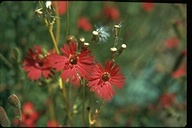| Unique Plants of the Puente Hills |
| On this page I will discuss some unusual and seemingly out of place plants found in the Puente Hills. These plants are not listed as occuring here, but yet here they are! Most of them are normally found further inland in the inland empire. This further shows the uniqueness of these hills, and why hiking here is so interesting. I will update this page as new species are discovered. California false-indigo (Amorpha californica) This shrub is a member of the Pea family and occurs in Powder Canyon, Turnbull Canyon, and Hacienda Hills Open Space. The greatest concentration is in Powder Canyon just above Schabarum Park. It is said to occur far inland, near Riverside, but someone forgot to tell these individuals! This plant is the only host plant for the larva of the California Dogface, our state butterfly! It is said to be an uncommon shrub, but the grove mentioned above contains at least thirty plants. It is deciduous and the leaves smell spicy when touched. False-indigo grows among the live oaks, both in shade and open sunlight. Squaw Bush (Rhus trilobata) A member of the Cashew family and related to Poison Oak, this deciduous shrub is usually found further inland in the valleys, and at higher elevations. It is found in Turnbull Canyon and Hacienda Hills. The berries are said to taste like lemons, just like the more common Lemonade Berry, but I have never seen them with fruit. The leaves are very soft and fuzzy, and the branches grow up and outward as if trying to grab you as you pass by. Squaw Bush grows on moister slopes and forms pure stands in some areas. Golden Current (Ribes aureum) This species is yet another normally found in inland communities. It is deciduous and the berries in early summer are very good, if you can get to them before the birds do! The yellow to orange flowers are small but very beautiful. It is found in Turnbull Canyon and Hacienda Hills in partially shaded canyons and ridges. Black Cottonwood (Populus trichocarpa) This riparian tree is found in Turnbull Canyon and Sycamore canyon, with a few in Arroyo Pescadero among the Arroyo Willows. Black Cottonwood is typically a higher elevation tree, but seems to have found the Puente Hills to its liking. The large oval shaped leaves turn a nice gold in fall, and flicker with the slightest breeze, creating a virtual sea of twisting and reflecting leaves. California Buckeye (Aesculus californica) This is a very unique find since buckeyes are very common in Central California but unknown south of the Grapevine, yet here they are! There is a large grove in Hacienda Heights surrounded by homes, but apparently naturally occuring. The large copmpound leaves fall late in summer to conserve water. The flowers are produced in candlabra-like spikes and smell very sweet. The large pods look somewhat like pears, and contain seeds the size of plums. Scrub Oak (Quercus berberidifolia) This is a common oak in chaparral, but is only known to occur in the Puente Hills from Powder Canyon eastward. Therefore in the areas where we can currently legally hike Powder Canyon is the only place to see this neat tree. Only two individuals are known to be there, and one is the largest I have seen. It looks different from its widespread cousin, Coast Live Oak. The leaves are flat and smaller, and the trees are more open and airy. Snowberry (Symphoricarpus mollis) This deciduous shrub is only found in Turnbull Canyon, Powder Canyon, and Hacienda Hills. The leaves are small and soft like felt, and the white berries are attractive in summer. It occurs along moist slopes and often forms pure stands. |
| To continue click here! |
 |
 |
| Part One |